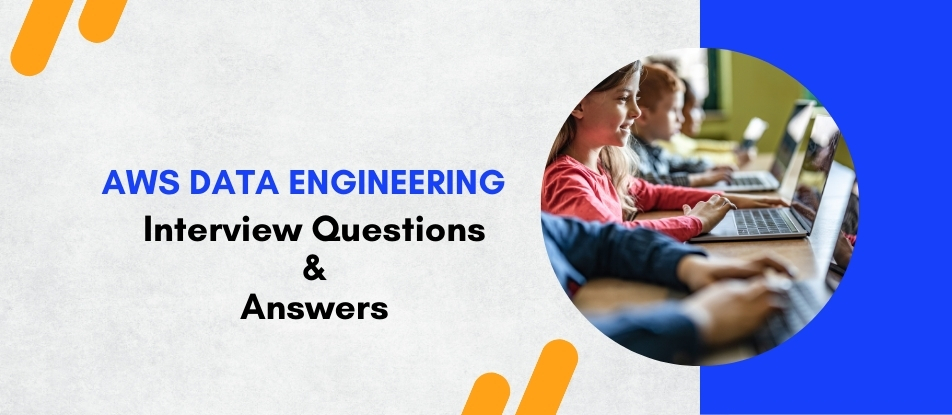
Unlock the full potential of AWS for data engineering with this comprehensive course designed for professionals seeking to deepen their expertise. Learn to build scalable data solutions using AWS tools like Redshift, Glue, and RDS. From data collection and warehousing to advanced analytics and real-time data processing, this course covers all key concepts, supported by hands-on labs and real-world scenarios, preparing you to lead data-driven projects efficiently.
AWS Data Engineering Training Interview Questions Answers - For Intermediate
1. Explain the AWS IAM service and its importance for data security.
AWS Identity and Access Management (IAM) allows you to manage access to AWS services and resources securely. Using IAM, you can create and manage AWS users and groups, and use permissions to allow and deny their access to AWS resources, which is critical for maintaining data security.
2. What is Amazon DynamoDB, and how does it handle data scaling?
Amazon DynamoDB is a NoSQL database service that provides fast and predictable performance with seamless scalability. DynamoDB handles data scaling automatically through partitioning and re-partitioning data as it grows, without impacting performance.
3. Discuss AWS Data Pipeline and its use cases.
AWS Data Pipeline is a web service that helps you automate the movement and transformation of data. It is used for data-driven workflows, such as moving data along a processing pipeline from one service to another or scheduling regular data processing jobs.
4. How does AWS support real-time analytics?
AWS offers several services that support real-time analytics, including Amazon Kinesis for data streaming, Amazon Elasticsearch Service for real-time search and analytics, and AWS Lambda for executing code in response to events.
5. What are the best practices for disaster recovery in AWS?
Implementing a well-architected framework with multi-region backup solutions, using Amazon S3 for cross-region replication of data, ensuring databases are in multiple availability zones, and regularly testing recovery procedures to ensure data integrity and availability.
6. How would you design a scalable architecture for a big data application in AWS?
Use a combination of Amazon S3 for durable, scalable storage, AWS Glue for data preparation and loading, Amazon Redshift or Amazon EMR for data processing and analytics, and leverage auto-scaling and AWS Lambda for flexible, event-driven computation.
7. Explain how caching is managed in Amazon RDS.
Amazon RDS supports caching through its DB instances which have query caches to improve read performance. RDS also integrates with Amazon ElastiCache to further enhance application performance via in-memory cache layers.
8. What is AWS CloudFormation and how can it benefit a data engineer?
AWS CloudFormation provides a way to use programming languages or a simple text file to model and provision, in an automated and secure manner, all the resources needed for your applications across all regions and accounts. This service benefits data engineers by simplifying the setup of data infrastructures.
9. Discuss the concept of serverless architectures and their relevance to data engineering.
Serverless architectures allow developers to build and run applications without managing servers. For data engineering, this means automated scaling, high availability, and event-driven processing, which can be beneficial for handling variable workloads and real-time data processing.
10. How does AWS handle big data security?
AWS provides comprehensive security capabilities to ensure privacy and control network access. These include network firewalls, encryption in transit with TLS, and encryption at rest using keys managed through AWS KMS, IAM for fine-grained access control, and VPCs for isolated network environments.
11. What is the role of Amazon SQS in data processing workflows?
Amazon Simple Queue Service (SQS) is used as a message queue service to decouple and scale microservices, distributed systems, and serverless applications. In data processing, SQS can help buffer and manage data transmission between different components of an application.
12. Describe how AWS Step Functions are used in data workflows.
AWS Step Functions coordinates multiple AWS services into serverless workflows so you can build and update apps quickly. In data workflows, Step Functions manage the orchestration of complex processes like data transformation and analysis tasks.
13. What challenges might you face when migrating an on-premise database to AWS, and how would you overcome them?
Challenges include data integrity issues, downtime during migration, and compatibility issues. These can be mitigated by using AWS DMS for a smooth transition, performing thorough testing, and planning for incremental migration to reduce downtime.
14. How can AWS X-Ray help in monitoring data applications?
AWS X-Ray helps developers analyze and debug production, and distributed applications, such as those built using a microservices architecture. X-Ray provides an end-to-end view of requests as they travel through the application, and shows a map of the application’s underlying components.
15. What strategies can be employed to reduce costs in AWS while managing large datasets?
Strategies include optimizing storage by classifying data based on access patterns and using the most cost-effective storage options, utilizing reserved instances for predictable workloads, and turning off unused resources to minimize costs.
AWS Data Engineering Training Interview Questions Answers - For Advanced
1. What considerations should be taken when implementing end-to-end encryption on AWS?
Implementing end-to-end encryption in AWS requires consideration of both data in transit and at rest. Utilizing services like AWS KMS for managing encryption keys, implementing TLS for data in transit, and using client-side encryption for sensitive data are essential. It’s also important to adhere to best practices for IAM policies and roles to ensure that data access is securely controlled.
2. How do AWS analytics services handle large-scale data warehousing?
AWS handles large-scale data warehousing with Amazon Redshift, which provides a scalable, secure, and cost-effective data warehouse service. Redshift's architecture allows for handling large-scale datasets and complex queries efficiently. Features like Redshift Spectrum and data lake integration extend its capabilities to manage unbounded data sets effectively.
3. Describe the process of automating ETL tests in AWS.
Automating ETL tests in AWS can be achieved by using AWS Glue for scripting ETL jobs and leveraging AWS Lambda for triggering test executions based on schedules or events. Using services like Amazon S3 for staging test data, and Amazon RDS or DynamoDB for test result storage allows for robust, scalable ETL testing workflows.
4. What are the best practices for securing a multi-tenant environment in AWS?
Securing a multi-tenant environment in AWS involves isolating tenants through VPCs, security groups, and IAM roles to ensure that each tenant's data and resources are protected. Implementing AWS Shield for DDoS protection, and regularly auditing configurations with AWS Config ensures environments remain secure.
5. How can Amazon ElastiCache improve database performance?
Amazon ElastiCache improves database performance by providing a high-speed, in-memory data store and cache. This reduces the load on databases by storing frequently accessed data in a faster-access storage medium, significantly speeding up read-intensive application workloads.
6. Discuss the integration of third-party tools with AWS for data analytics.
Integrating third-party tools with AWS for data analytics can enhance capabilities and provide specialized functionalities. AWS supports integration with popular tools like Tableau for visualization, Splunk for log analytics, and more through direct connectors and APIs. This allows businesses to leverage their existing tools while benefiting from AWS’s scalability and security.
7. Explain the concept of data mesh in the context of AWS.
Data mesh is a decentralized approach to data architecture and organizational design. In AWS, this concept can be implemented using services like AWS Lake Formation and AWS Glue, which provide the infrastructure for domain-oriented data ownership and governance, making data accessible as a product across the business.
8. What are the implications of serverless architectures on data processing workflows in AWS?
Serverless architectures impact data processing workflows by providing highly scalable, event-driven execution models that reduce operational overhead and cost. Using AWS Lambda and Amazon S3, data processing can be triggered directly by data changes, and scale automatically with the volume of data without the need for managing servers.
9. How can AI and ML be leveraged in AWS to improve data quality?
AI and ML can be leveraged in AWS to improve data quality through services like Amazon SageMaker, which can train machine learning models to detect anomalies, predict values, and automate data cleansing processes. Integrating these capabilities can enhance the accuracy, consistency, and reliability of data assets.
10. What are the key performance indicators for monitoring AWS data services?
Key performance indicators for AWS data services include latency, throughput, error rates, and service availability. Monitoring tools like AWS CloudWatch can track these metrics, providing insights into the performance and health of data services and helping diagnose and resolve issues promptly.
11. Discuss the use of AWS Direct Connect in the context of hybrid networks for large data transfers.
AWS Direct Connect establishes a dedicated network connection from an on-premises network to AWS, facilitating large data transfers by providing a more consistent network experience than Internet-based connections. This is particularly beneficial for hybrid networks where large amounts of data are regularly transferred between on-premises environments and AWS, reducing bandwidth costs and improving transfer speeds.
12. Explain data virtualization benefits in AWS and how it can be achieved.
Data virtualization in AWS can be achieved through services like Amazon Redshift Spectrum and AWS Glue Elastic Views, allowing users to access and query data across various AWS data stores in real time without replicating the data. This approach offers flexibility, reduces storage costs, and speeds up data access across heterogeneous data environments.
13. How does AWS ensure data lineage and tracking across its services?
AWS ensures data lineage and tracking through integrated logging and monitoring services like AWS CloudTrail, AWS Config, and the metadata management capabilities of AWS Glue. These services help in tracking data modifications, access, and movement across different services, ensuring auditability and compliance.
14. What are the advanced techniques for data encryption and key management in AWS?
Advanced techniques for data encryption and key management in AWS involve using AWS KMS for centralized key management, enabling automatic key rotation, and employing customer-managed keys for sensitive data. Techniques like envelope encryption enhance security by using multiple keys for data at rest.
15. Discuss the scalability challenges with AWS databases and strategies to overcome them.
Scalability challenges with AWS databases often involve managing large volumes of data and high throughput. Strategies to overcome these include using Amazon RDS read replicas to distribute read traffic, employing Amazon DynamoDB's auto-scaling capabilities to adjust capacity automatically, and partitioning data in Amazon Redshift to distribute queries across nodes effectively.
Course Schedule
| Apr, 2025 | Weekdays | Mon-Fri | Enquire Now |
| Weekend | Sat-Sun | Enquire Now | |
| May, 2025 | Weekdays | Mon-Fri | Enquire Now |
| Weekend | Sat-Sun | Enquire Now |
Related Courses
Related Articles
Related Interview
Related FAQ's
- Instructor-led Live Online Interactive Training
- Project Based Customized Learning
- Fast Track Training Program
- Self-paced learning
- In one-on-one training, you have the flexibility to choose the days, timings, and duration according to your preferences.
- We create a personalized training calendar based on your chosen schedule.
- Complete Live Online Interactive Training of the Course
- After Training Recorded Videos
- Session-wise Learning Material and notes for lifetime
- Practical & Assignments exercises
- Global Course Completion Certificate
- 24x7 after Training Support







 (1).png)




 Join our Live Instructor-Led online classes delivered by industry experts
Join our Live Instructor-Led online classes delivered by industry experts